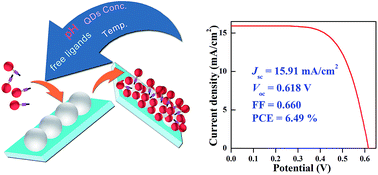Optimizing the deposition of CdSe colloidal quantum dots on TiO2 film electrode via capping ligand induced self-assembly approach†
Abstract
The deposition method for immobilizing quantum dots on a TiO2 film electrode is crucial for the photovoltaic performance of the resulting quantum dot sensitized solar cells (QDSCs). The recently developed capping ligand-induced self-assembly approach has been demonstrated to be an effective deposition route with fast, dense and uniform immobilization of the pre-prepared colloidal QDs on the TiO2 film electrode. In order to make this technique more reproducible and applicable, the influences of variable experimental parameters, including pH, free ligand concentration, deposition temperature, and QD concentration, on the loading amount and photovoltaic performance of the resulting cell devices have been systematically investigated with the use of CdSe QDs as a model. The intrinsic mechanism of the effects from these investigated variables has been elaborated primarily. An average power conversion efficiency of 6.49% (Jsc = 15.91 mA cm−2, Voc = 0.618 V, FF = 0.660) under the irradiation of full one sun (AM 1.5G) has been obtained for the CdSe-based QDSCs under the optimum QD deposition conditions.


 Please wait while we load your content...
Please wait while we load your content...